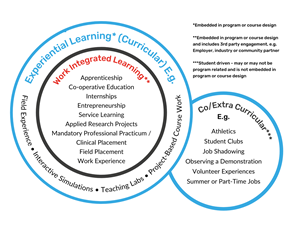Thank you! I relocated to Prince George from Ontario as I was looking for a job that would allow me to use my teaching experience to facilitate great learning. I’m originally from Vancouver but spent the past 10 years in Ontario doing interdisciplinary research and teaching a variety of subjects.
At McMaster University, I spent a lot of time working on professionalization for undergraduate students. Providing students with meaningful work opportunities is important to me and I’m confident that experiential and work-integrated learning will be playing a much larger role in higher education in Canada.
"Nothing is more exciting than seeing a student grow confidence as they learn new skills and deepen their knowledge and understanding of the world."
What is experiential and work-integrated learning and how does it enhance student learning?
Experiential learning (EL) is a hands-on, reflective process where students actively engage in real-world experiences to develop skills, knowledge, and personal insights. This can be done through field and lab experiences, simulations, or project-based course work for example. Importantly, not all experiential learning requires curricular changes; a lot of it can be integrated into existing courses—and I’m here to support faculty with that.

EL is the umbrella under which work-integrated learning (WIL) falls. WIL is an educational approach combining academic study with practical workplace experience, enabling students to apply theory to real-world professional contexts. It requires the participation of three parties: students, faculty, and an employer, industry, or community partner.
For students, EL and WIL are a chance to bring what they learn in the classroom to life. It prepares students as they enter the job market, and it sets graduates apart from peers who didn’t benefit from EL and WIL.
What are some of the things people may not know about EL and WIL?
One thing I’ve heard a lot is that experiential learning demands more time from teaching faculty. The trick is really to find a way to make experiential learning work for you. EL and WIL can be daunting at the beginning, but I really want to encourage people to share ideas and talk through potential plans together. Being in community with colleagues makes teaching and learning more manageable and enjoyable.
Also, there are many grants available for applied and theoretical research surrounding EL, WIL and other areas in the scholarship of teaching and learning, as well for employers to host WIL students. I’m currently working on a grant database to help us create more experiential learning opportunities that benefit CNC students.
How are you helping instructors who are looking to integrate EL into their teaching?
I support faculty in developing new assignments and class activities that are experiential or looking for WIL opportunities. I can help with smaller projects, like aligning EL with existing course learning outcomes, or larger projects that require curriculum changes. I warmly invite faculty to connect with me—even with half-formed ideas. In my experience, half-formed ideas have amazing potential when they are developed in dialogue.
And what about third parties who are interested in working with CNC to facilitate work-integrated learning?
I have been networking with potential industry partners on the benefits of work-integrated learning to both employers and students—not to mention, the Prince George community.
Co-operative Education and Work-Integrated Learning Canada has a handy
employer and community partner toolkit that provides a clear place to begin for organizations considering the integration of WIL in their workplace.
We’re also working towards an open house and information packages for current and future industry partners on work-integrated learning. So please join us or reach out to the
Centre for Teaching and Learning—even if you are uncertain of how WIL might fit into your business. It’s a chance to bring in new talent and potentially recruit future employees who are well-trained and familiar with the unique needs of the workplace. It’s also a great way to keep Prince George talent in the region, which I believe is really important to the well-being and health of our community.